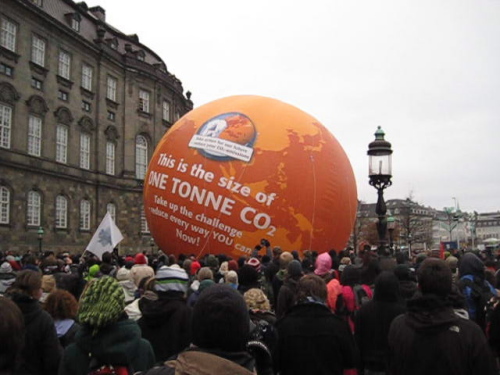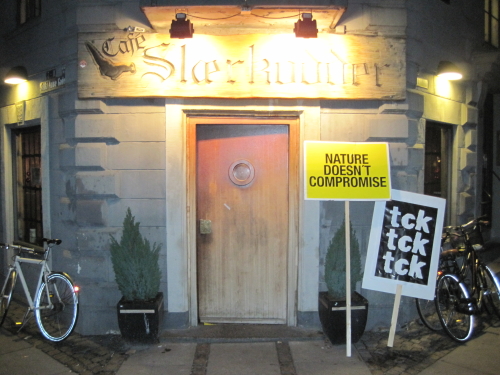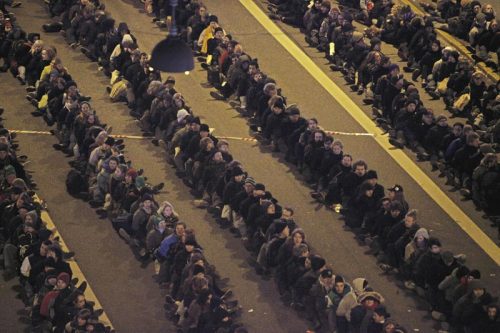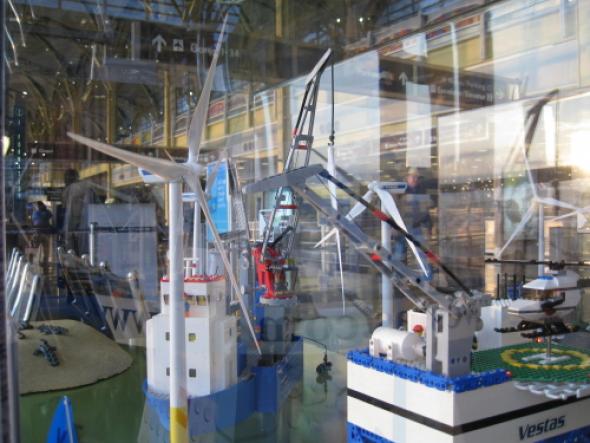Hopenhagen against Hope
Amidst the general eco-panic and its commodification, Ilya Lipkin travelled to the Copenhagen Summit to witness capitalism's first last chance at preserving a climate conducive to its growth
Situating COP15: Capitalist Logic and Subjectivity
In attempting to process COP15, the UN Summit on Global Warming that took place in Copenhagen this past December 2009, what must be avoided is a ‘neutral' and static representation of the highly politicised dynamics, both global and local, that constituted this event. Writing these lines, I immediately recognise the uneasy tension between providing information that more or less accurately historicises and recounts the summit, and the need to avoid rendering objective or continuous that which is not. This desire for subjective discontinuity stems from the urgent necessity to reject all depictions of the global warming crisis as anything other than a political problem. Without a concrete grounding in the political, any attempt to address the economic dimension of climate change would end in abstraction. Thus, when I say ‘subjective discontinuity' I do not here mean a kind of relativism in relation to experience. I speak of the discontinuity of the real, and the understanding that to become a subject is fundamentally tied up with the collective imagining and militant commitment to that which is deemed impossible in the present order of things.[1] I believe that any understanding of COP15 must begin with the assertion of one's subjectivity in the face of ‘common sense'. This insistence helps in turn reveal what is at stake in our reflecting on COP15: much as with other recent events tied to deep structural dynamics (such as the financial crisis), our interpretation and understanding of this event directly informs the horizon of political possibilities available to us in the present.
Capitalism tends to suppress such a conception of the subject by routinely and vigorously foreclosing possible alternatives to the way in which social relations are currently structured. In the face of every crisis tied to the unsustainability of a continuous growth economy, attempts at envisioning an emancipatory politics in the present are routinely equated with a return to totalitarian fantasies. For example, while hardly radical and clearly problematic in their own right, efforts to move towards the socialisation of healthcare or the drafting of legislation to regulate financial markets were both immediately denounced throughout much of the American media as a conspiracy by the left to slowly pave the way to communism. These reactive, at times delusional claims are generally coupled with a slew of essentialist notions and a return to an Enlightenment era humanism filtered through current modes of representational politics (primarily through the equation of ‘inalienable freedoms for all' with free markets and the right to private property). This should come as no surprise: since the rise of neoliberalism in the late '70s and certainly since the collapse of the Soviet Union, we have been living in a period of restoration. However, it is important to keep in mind that the suppression of alternative visions of social relations is not only connected to a project of the restoration and maintenance of class power. It is also fundamental to the continuous and uninterrupted process of territorialisation, most obviously in the ceaseless and violent hammering out of new zones of investment for surplus capital. The current ideological dominance of the leitmotifs of ‘freedom' and ‘human rights' plays a central role in maintaining the imperative of continuous growth, which in turn guarantees that the capitalist system lives to see another day. Has it not been drilled into us, since the times of Reagan and Thatcher, that ‘there is no alternative?'
With this in mind, it is difficult to see the COP15 summit as anything other than the extension of this very process of territorialisation and recuperation to the genuine problem of climate change. The primary function of the summit was to carve out new zones of investment and technical development. It is capital's indifference to the qualitative configuration of things - so long as they can be brought into alignment with market forces - that explains its extraordinary ability to accommodate the most diverse demands, including environmentalist ones. While paying lip service to the global warming crisis, the political leaders gathered at COP15 were never genuinely interested in exploring the fundamental relation between continuous growth, the depletion of natural resources and the destruction of the environment. A glance at the Copenhagen Accord, drafted up behind closed doors by the US, China, Brazil, India and South Africa, and recognised by the Parties to the UN Framework Convention on Climate Change, reveals the summit's true objective: ‘to use markets, to increase the cost-effectiveness of, and to promote, mitigation actions [against global warming].'[2]
The Copenhagen Accord, one of the few measurable ‘accomplishments' of the summit, goes on to say that
the collective commitment by developed countries is to provide new and additional resources [...] investments through international institutions, approaching USD 30 billion for the period of 2010-12 [...] with a goal of mobilizing USD 100 billion a year by 2020.[3]
The funding for this type of investment will come from ‘a wide variety of sources, public and private, bilateral and multilateral, including alternative sources of finance.'[4] To determine how this funding will be distributed and put to work, all of the investment capital will flow through the newly established Copenhagen Green Climate Fund. But the grisly record of another famous international fund, the IMF, makes it clear that even ‘public' investment of this nature expects a return, and hence ‘structural adjustment' policies that wreak wave upon wave of social dislocation.[5]
What is therefore strongly implied in the Copenhagen Accord is that relief from the ill effects of global warming and access to the technologies and capital that would allow developing nations to convert to sustainable modes of production comes at a price. Namely, a series of structural changes in compliance with the guidelines of those providing the resources. This should come as no surprise, as much of the thinking behind COP15 finds its origins in the neoliberal transition from the social-welfare model of the state, that took place in the '70s throughout much of Western Europe and America. However, the process of deindustrialisation and financialisation in the West heralded by this transition - a process that led to the current global hegemonic configuration - is currently in crisis. As the historian Giovanni Arrighi has pointed out, a period of financial expansion always occurs when the material expansion of productive forces reaches a limit. Financial expansion too has its limits: Arrighi refers to this as the ‘autumn' of a particular hegemon.[6] In other words, financial expansion is the concluding phase of a particular process of leadership in accumulation, resulting in eventual displacement by another leader. Or, as Karl Marx put it: autumn becomes a spring elsewhere, producing a sequence of interconnected developments.
Judging by the most recent market collapse, it would be fair to hypothesise that the process of financial expansion in the West has slowed down markedly, with the consequence that the configuration of global power is likely itself in deep and rapid transition. The COP15 summit reveals exactly how, on a global scale, political leaders from the dominant nations have attempted to capitalise on the problem of global warming to serve their own interests: as yet another tool for the maintenance of the current order of power and wealth, as well as a potential zone to be cultivated for the restoration of markets and the creation of new investment opportunities.
The pitfall in this type of thinking is the perfectly circular logic it requires. The leaders gathered at COP15 adopted neoliberal strategies to think through a problem that essentially stems from the type of growth demanded by capitalism. The summit's anxious reluctance to think of global warming as a political problem that is inextricable from the structure of social relations is yet another symptom of the tautological self-coherence of the ideologies of capital. If we believe that there is no alternative, then no alternative will present itself - no matter how devastating the human and environmental consequences. Hence, again, the urgency of refusing this purported ‘logic' and of centring the debate on its very terms.

Image: Protesters capture one tonne of carbon
Spectacle and Local Politics - COP15 and the City of Copenhagen
Equally as disturbing as the way in which COP15 was instrumentalised on a global scale, however, is the way this summit was put to work locally by the city of Copenhagen - or, as it was dubbed for the duration of the summit, ‘Hopenhagen'. This play on words, in all of its spectacular buffoonery, was very much in line with the general grooming of the city during COP15. I became aware of it immediately upon my arrival at Kastrup airport, as I was greeted by an artistic collaboration between Vestas and Lego in the form of several large windmills made of a million plastic blocks. Children and adults alike stopped to stare and photograph themselves in front of these creations and the miniature cities beneath. Upon leaving the airport and walking through the streets of the city, I encountered various posters, signs and advertisements promoting ‘green' products, ‘green' events, ‘green' concerts... . A particularly haunting recurrent image featured various individuals, probably meant to look like ‘third world natives,' staring back at me and inquiring: ‘What future do you want to live in?'
This fusion of consumerism, spectacularised culture and a sense of feel-good optimism reached its surreal peak during the speeches leading up to the main demonstration on 12 December. The over 100,000 people gathered in front of the parliament building found themselves addressed by the Danish actor Thure Lindhardt, who devoted a lengthy portion of his speech to exhorting the demonstrators to remain peaceful. Next up was the fashion model Helena Christensen - absurdist theatre at its best. Reading haltingly from a prepared statement, Ms. Christensen spoke of her concern about global warming, assured us of her activism, and encouraged us all to attend her exhibition of photographs at a local gallery. The theme of her show: the effects of global warming in Peru.
All of these campaigns and speeches served a single purpose: the promotion of Denmark as a progressive and prosperous nation that is sensitive to the eco-troubles of the world. COP15 played a central role in the larger project of cleansing, gentrification, and branding of the eco-friendly and global utopia of ‘Hopenhagen'. Behind this depiction, of course, lies a ‘common-sensical' understanding of real estate as investment and a desire to cultivate a business-friendly climate. One could not help but get the feeling that the parties responsible for these campaigns were fully aware of their strategic function in the larger ongoing local fight against the various activist and community groups resisting the forces of gentrification. Of course, the more pervasive and obvious these self-congratulatory promotional tactics, the greater the sense of disconnect: the corporate image of Copenhagen that was produced for and through the summit was utterly at odds with the daily stream of news of police violence and arrests, general confusion, and repeated breakdowns in the official talks among international delegates at the Bella Center.
In reality, squarely underpinning the sunny rhetoric was a series of calculated decisions by the Danish parliament that included the implementation of new laws facilitating preventive arrests and cracking down on civil disobedience during the summit. This ‘protest package' gave police the right to detain civilians for up to 12 hours even when no law had been infringed.[7] ‘Disturbing the peace' or disobeying police orders during a protest would result in a 40-day imprisonment.[8] Furthermore, special prisons were built in an old Carlsberg warehouse: 37 twelve square metre cages, each designed to hold ten protesters.[9] Arbitrary harassment and detainment were effectively legalised, and the contradiction between the official progressive rhetoric and the reality of a police state made absolutely blatant.
Even more worrying, though by no means shocking, was the fact that while these laws were purportedly passed to prevent disturbances during a visit by global leaders, they will remain on the books. The consequences for future demonstrations, protests and actions are drastic and potentially devastating. In a city endowed with a strong anti-capitalist activist movement, resistance to state power will, from now on, be more difficult still.
A Demonstration - Collective Resistance to COP15
The panoply of forces of resistance, global and local, in all of their multiplicity, contradiction and collective power, was in full evidence during the main demonstration against COP15 on 12 December, 2009. Following the aforementioned speeches on the steps of the Danish parliament, a gigantic assortment of bodies, banners and vehicles, with the usual police accompaniment, set into motion on a long, slow march towards the Bella Center. My friends and I began our trek alongside a truck to the sounds of Max Romeo and the Upsetters' ‘I Chase the Devil.' As the hours wore on, our collective mood was stoked by a rousing speech made by Lars Grenaa of the Communist Workers' Party. Speaking in English, Mr. Grenaa powerfully and succinctly outlined the relationship between COP15, the interests of capital and the need for system change if the problem of global warming is to be addressed properly. While he delivered his message, a large banner reading ‘FCK FCK FCK the System' elicited smiles and cheers as it swayed from the back of his truck.
High spirits and a sense of excitement pervaded the march, even as the mass of protesters ebbed and flowed. At one point, rumours began to circulate of people being held back. We would not find out until much later in the night that, indeed, one thousand demonstrators had been preemptively arrested and made to sit hand-cuffed on the cold ground for several long hours.[10] Many soiled their pants because they were not allowed access to a bathroom. These arrests occurred under the transparent pretext that those detained were plotting a violent action and were not part of the ‘official demonstration'. However, because of a lack of communication and the massive police presence forcing the protesters forward, we continued on our way blissfully unaware of what had just transpired.
Sunset came and went, and in the glow of the street lights an atmosphere of celebration descended upon us. The music from the trucks got louder and more upbeat, people began dancing furiously in a throbbing ocean of banners, signs, balloons and flags. Many who lived on the streets we marched down threw open their windows, hung out banners and waved their support to the demonstrators. For a fleeting moment it felt as though our differences had been genuinely superseded by collective euphoria: no more ‘you', no more ‘me' - we were one organic mass that cried out ‘NO!' to COP15 and ‘NO!' to capitalism.

Image: 'My friends and I stood up, and slowly made our way to the nearest bar.'
By the time we arrived at the Bella Center, however, much of this powerful energy had dissipated; a feeling of deep ambivalence hung over the conclusion of this protest. Perhaps this was unavoidable: after all, this demonstration had been organised largely by NGOs, it obeyed the guidelines set forth by the Danish authorities, and those involved stopped short of engaging in a confrontation with the law. Admittedly, it would be presumptuous of me to speculate on exactly what drew protesters to this demonstration in the first place. This is especially true when ‘protestors' refers not to a homogenous mass, but to a multiplicity of bodies with a wide range of backgrounds, political views and desires. After all, this demonstration brought together groups as varied as anarchist collectives, black-blocers, Greenpeace, Philippine fishermen, communists, social democrats, and a plethora of eco-activists. Yet it is clear that whatever the demands of each group or individual may have been, these demands were largely overdetermined by the circumstances through which they were made public. Cynicism aside, it is tempting to read the demonstration as a mass process of repressive desublimation: without confrontation, without transgression, without any rupturing of the rules set forth by power, it might easily seem that the protest functioned primarily as a collective emotional outlet. Such an experience has of course value in its own right, providing one with a momentary space in which to experience collectivity and to voice frustration. Ultimately, however, the political impact of this event was limited by its existence solely within a temporal and physical space granted to it by the authorities. As such, the demonstration could do little more than legitimate the power of the state and underscore its ‘tolerance' towards dissent.
It was not long after this demonstration, on Monday the 14th to be precise, that the Danish authorities cleared up any lingering illusion concerning the power dynamics between demonstrators and the police within the city. Late that evening, approximately three hundred people were arrested as the police stormed Christiania with tear gas, following a talk given by Michael Hardt and Naomi Klein.[11] Many had to find refuge in the free city itself for the duration of the night, as leaving without harassment or arrest was next to impossible. Furthermore, the action planned at the talk - entering the Bella Center and encouraging the delegates to come out and speak to the activists - was also brutally foiled on Wednesday the 16th.[12] As the summit drew to a close, the activists and demonstrators gathered in Copenhagen were faced with the harsh reality that, at least this time around, victory would remain elusive.

Image: 1,000 protesters handcuffed in the cold
Postscript
On one of the last nights of the summit, I happened to walk with friends past the Folkets Hus in Nørrebro. On an adjacent street, someone had just set fire to a dumpster and as black smoke filled the air, eager youths ran up to feed it wood and detritus. I immediately thought of somehow incorporating this fire into my text; it invited meaning. As we were all exhausted from the events of the week, we sat down on some stones nearby and watched the flames tickle the night sky. The smell of burning plastic wafted through the air. I tried to jot down a few notes, to no avail. After some time, I began to suspect that what drew me to this image was that it made no demands: it was simply, stupidly there. Days later, I thought again about how to politicise it, how to recuperate it, speak to it and of it, but this encounter remained elusive: an act of wordless violence that had nothing to do with ‘politics'. That night, when the police and the fire brigade arrived, my friends and I stood up, and slowly made our way to the nearest bar.
Footnotes
[1] My understanding of subject formation here draws heavily from the philosopher Alain Badiou and his definition of the subject as it appears in his book Ethics: ‘I call "subject" the bearer of a fidelity, the one who bears a process of truth. The subject in no way pre-exists the process. He is absolutely nonexistent in the situation "before" the event. We might say that the process of truth induces a subject... to be sure, the militant enters into the composition of this subject, but once again it exceeds him.' Badiou goes on to say that ‘Events are irreducible singularities, the "beyond the law" of situations. Each faithful truth process is an entirely invented immanent break with the situation.' Thus, the process of entering into subjectivity implies a break with the individual and calls for the ‘becoming immortal' of the subject through the collective. And simultaneously, it insists on a commitment to the impossible of a situation because of the necessity of an immanent break with all that provided the ground for the emergence of said subject. For further reading please refer to: Alain Badiou, Ethics, New York: Verso, 2001.
[2] The Copenhagen Accord, in its entirety, can be downloaded here: http://www.denmark.dk/en/menu/Climate-Energy/COP15...
[3] Ibid.
[4] Ibid. Emphasis mine.
[5] For further reading on the IMF see David Harvey, A Brief History of Neo-Liberalism, New York: Oxford University Press, 2005.
6 Giovanni Arrighi, ‘The Winding Paths of Capital, Interview by David Harvey', New Left Review, Mar./Apr. 2009, 56, pp. 61-94, http://hap.bloger.hr/post/the-winding-paths-of-cap...
[7] For further reading please refer to: Jeppe Funder, ‘Harsh protest laws passed for COP15', Reportage/enviro, 7 December, 2009, http://www.reportage-enviro.com/2009/12/harsh-prot...
[8] Ibid.
[9] Ibid.
[10] ‘100,000 Protest at COP15, Police make Mass Arrests', Indymedia Danmark, 12 December, 2009,
http://indymedia.dk/articles/1526
[11] Bibi van der Zee, ‘Copenhagen: 194 arrested after protesters set fire to barricades', Guardian, 15 December, 2009, http://www.guardian.co.uk/environment/2009/dec/15/...
[12] ‘No Justice for Climate in Copenhagen', Indymedia Danmark, 16 December, 2009, http://indymedia.dk/articles/1830
Ilya Lipkin <ilyalipkin AT gmail.com> is an artist living in Berlin
Mute Books Orders
For Mute Books distribution contact Anagram Books
contact@anagrambooks.com
For online purchases visit anagrambooks.com








